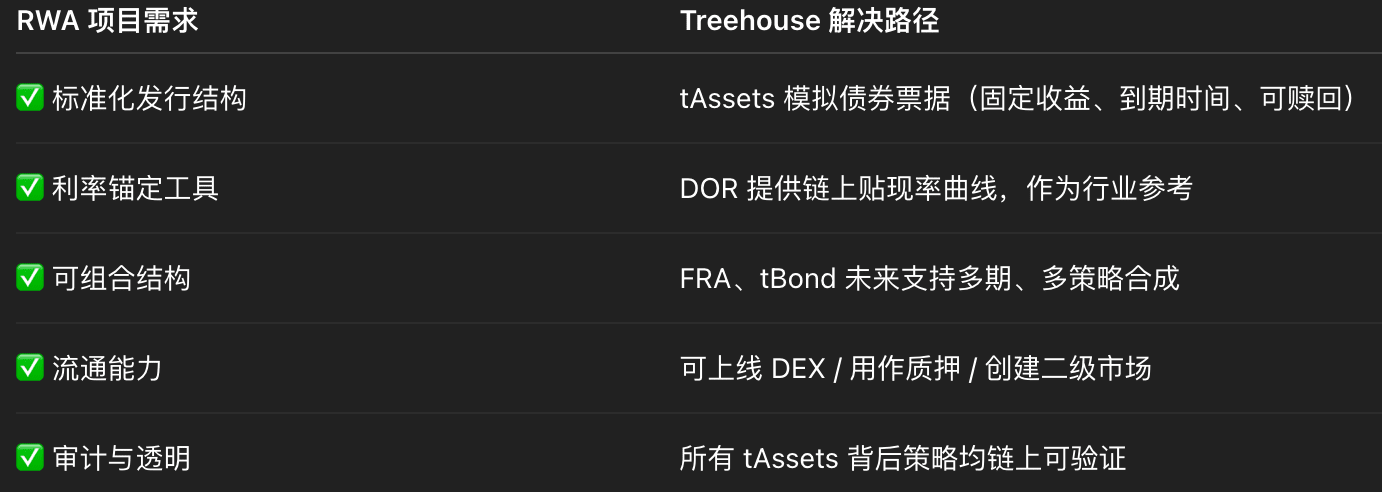Written by: Qingfeng btc | Structured Finance Researcher / Crypto Market Analyst
As RWA (Real World Assets) becomes a new narrative with mainstream institutions and crypto projects betting simultaneously, the issues of on-chain debt issuance, yield management, and interest rate pricing systems are becoming real and urgent.
We see that:
BlackRock issues US Treasury bonds on the chain.
MakerDAO launches RWA subsidiary.
Protocols like Ondo / Backed issue tokenized bonds.
Major DAOs are beginning to experiment with allocating stable yield-type assets.
In this trend, the value of Treehouse gradually comes to light—it is not a traditional DeFi wealth management protocol, but is becoming:
A 'fixed income infrastructure layer' that provides on-chain debt issuance, yield standardization, interest rate anchoring, and re-circulation capabilities for RWA.
In this article, we will analyze the current state of RWA and how Treehouse can build a natural coupling relationship to determine whether it can become the 'basic settlement platform' for on-chain debt.
1. Current Issues with RWA: The 'Incomplete Debt Path' on the Chain
Although many projects boast 'tokenized T-bills' and 'on-chain bonds', achieving a truly composable and manageable on-chain fixed income asset system still faces three core challenges:
1️⃣ Lack of Standard Note Formats
The bond structures in reality are complex (terms, yields, discount methods), while most on-chain RWA projects 'package them into one token' without a unified interface, making it impossible to participate in combinations, secondary trading, or re-staking.
2️⃣ Lack of Interest Rate Anchor Reference
Different RWA projects have significant yield differences, lacking a similar SOFR on-chain interest rate anchor, leading to price chaos and inability to establish consensus.
3️⃣ Lack of Structured Asset Platforms
In reality, there are bond markets, ABS markets, interest rate swap markets, etc., but on-chain lacks infrastructure similar to 'repackaging + combination + resale + trading', causing RWA tokens to become 'dead assets'.
Thus, the market calls for a 'qualified, structured, standardized debt asset platform' to emerge on-chain.
2. How does Treehouse form a natural coupling with RWA?
The underlying design logic of Treehouse naturally aligns with the 'on-chain landing demand' of RWA:

3. Practical Scenario Examples: How DAOs, stablecoin protocols, and asset issuers can use Treehouse?
✅ Scenario 1: DAO Treasury Allocating RWA Assets
For example, if MakerDAO wants to allocate part of its treasury for stable yields:
Use funds to purchase RWA tAssets packaged through Treehouse (e.g., USDC-backed US Treasury structures).
Set maturity dates / yields to ensure annual expected returns.
Use DOR to price future yields and record them in the on-chain financial system.
The yield path is fully traceable on-chain and can serve as a direct reference for DAO budgets.
✅ Scenario 2: Stablecoin Protocol Backing Asset Yields
A certain protocol launches a stablecoin and hopes to have real assets as backing:
Buying real government bonds with dollar assets.
After tokenization, connect to the Treehouse system, converting to on-chain tAsset.
The stablecoin system uses this asset as collateral and prices its value through DOR discounting.
The system can view interest rate curve changes in real time and adjust the currency peg anchoring path.
This not only enhances the transparency of stablecoin backing but also reduces regulatory resistance.
✅ Scenario 3: Real Asset Issuers Entering DeFi
If bond funds from Franklin Templeton and BlackRock wish to open up part of their subscriptions on-chain:
You can choose to package the notes into a tAsset that can be held on-chain through Treehouse.
Then integrate into decentralized circulation systems (DEX / Wallet / Protocol End).
Investors can subscribe based on different terms, risk preferences, and discount rates.
This process is fully compliant, transparent, and standardized, providing an on-chain path for traditional asset circulation.
4. How far Treehouse can go depends on which factors?
To truly become 'on-chain debt infrastructure', Treehouse still faces key path dependencies:
1️⃣ Industry Adoption of DOR
To become the anchor point for bond pricing, DOR must gain adoption from protocols, DAOs, and stablecoin systems, and may even become the 'on-chain central bank curve'.
2️⃣ Compliance Expandability of tAsset
Can the packaged assets support RWA sources? Can they support cross-chain for BTC / L2 / Cosmos? Is the regulatory compliance structure complete?
3️⃣ Infrastructure Interoperability
Do they support collaborations with projects like MakerDAO, LayerZero, Circle, Realio, Ondo, etc., to connect the paths of issuance → staking → re-trading → secondary market?
5. Conclusion: Treehouse is attempting to establish an on-chain 'Bloomberg + iBonds' integrated structure.
It is neither a wealth management protocol that only serves retail investors nor a simple structured note issuance platform, but rather:
Constructed an on-chain fixed income financial system with interest rates as the center, debts as asset standards, and combinations as the core.
The RWA boom is not a short-term fad, but a long-term path demand for real capital to 'enter the on-chain'.
In this era, protocols like Treehouse that are rigorously designed, structurally reusable, and independently rate systems are very likely to become:
📈 The 'bond layer' and 'discount engine' of the on-chain capital market.
